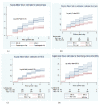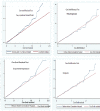Incidence and predictors of mortality among low birth weight neonates in the first week of life admitted to the neonatal intensive care unit in Northwestern Ethiopia comprehensive specialized hospitals, 2022. Multi-center institution-based retrospective follow-up study
- PMID: 37759160
- PMCID: PMC10523684
- DOI: 10.1186/s12887-023-04319-0
Incidence and predictors of mortality among low birth weight neonates in the first week of life admitted to the neonatal intensive care unit in Northwestern Ethiopia comprehensive specialized hospitals, 2022. Multi-center institution-based retrospective follow-up study
Abstract
Background: Globally, a high number of neonatal mortalities occurs in the first week of life, particularly among low birth weight neonates in low-income countries, including Ethiopia. However, there is limited evidence on the early neonatal mortality of low-birth-weight neonates in Ethiopia. Therefore, this study aimed to assess incidence and predictors of mortality among low-birth-weight neonates in their first week of life admitted to the neonatal intensive care unit in Northwestern Ethiopia Comprehensive Specialized Hospitals, 2022.
Methods: A multi-center retrospective follow-up study was conducted from March 21, 2020 to March 1, 2022, among 761 early neonates with low birth weight admitted in Northwestern Ethiopia Comprehensive Specialized Hospitals. The study participants were selected using simple random sampling technique. Data were collected using a data abstraction checklist ,and checked for completeness and entered into EPI data version 4.6, then exported to STATA 14 for analysis. Kaplan Meier failure curve and log-rank test were used to estimate and compare the probability of death. Both bivariable and multivariable Weibull regression models were fitted to identify predictors of mortality. Finally, a hazard ratio with 95% CI was computed, and variables having a p-value < 0.05 were considered as a significant predictor of mortality.
Results: The incidence of mortality among low birth weight neonates in their first week of life was 75.63 per 1000 neonate day observation (95% CI: 66.76-85.67), preeclampsia (AHR = 1.77;95% CI:1.32-2.36s), perinatal asphyxia (AHR = 1.64; 95% CI:1.14-2.36), respiratory distress syndrome (AHR = 1.76 95% CI;1.31-2.34), necrotizing enterocolitis (AHR = 2.78 95% CI;1.79-4.32), prematurity (AHR = 1.86; 95% CI:1.30-2.67), and birth weight < 1000gram (AHR = 3.13;95% CI: 1.91-5.12) and 1000-1499 gram (AHR = 1.99; 95% CI:1.47-2.68) were predictors.
Conclusion: The incidence of early neonatal mortality in low birth weight neonates was incredibly higher than the overall early neonatal mortality in Northwest Ethiopia (Amhara region). Preeclampsia, perinatal asphyxia, respiratory distress syndrome, necrotizing enterocolitis, prematurity, and birth weight were predictors of mortality. Therefore, stakeholders shall give early identification and emphasis on preventable and treatable predictors. Furthermore, the health care provider shall give education about the importance of breastfeeding, and Antenatal and postnatal care.
Keywords: First week of life; Incidence; Low birth weight; Mortality; Predictors.
© 2023. BioMed Central Ltd., part of Springer Nature.
Conflict of interest statement
The author declares that they have no conflict of interest.
The authors declare no competing interests.
Figures



Similar articles
-
Incidence and predictors of mortality among neonates with respiratory distress syndrome admitted at West Oromia Referral Hospitals, Ethiopia, 2022. Multi-centred institution based retrospective follow-up study.PLoS One. 2023 Aug 1;18(8):e0289050. doi: 10.1371/journal.pone.0289050. eCollection 2023. PLoS One. 2023. PMID: 37527266 Free PMC article.
-
Incidence and predictors of respiratory distress syndrome among low birth weight neonates in the first seven days in Northwest Ethiopia Comprehensive Specialized Hospitals, 2023: A retrospective follow-up study.BMJ Open. 2023 Nov 19;13(11):e079063. doi: 10.1136/bmjopen-2023-079063. BMJ Open. 2023. PMID: 37984945 Free PMC article.
-
Incidence of acute kidney injury and its predictors among neonates admitted at neonatal intensive care unit of, Northwest Ethiopia comprehensive specialized hospitals, 2023.BMC Pediatr. 2024 Nov 11;24(1):717. doi: 10.1186/s12887-024-05147-6. BMC Pediatr. 2024. PMID: 39528961 Free PMC article.
-
Incidence and predictors of mortality among neonates admitted with birth asphyxia to neonatal intensive care units in Ethiopia: a systematic review and meta-analysis.BMC Pediatr. 2025 Feb 26;25(1):140. doi: 10.1186/s12887-025-05481-3. BMC Pediatr. 2025. PMID: 40001015 Free PMC article.
-
Factors associated with neonatal jaundice among neonates admitted at referral hospitals in northeast Ethiopia: a facility-based unmatched case-control study.BMC Pregnancy Childbirth. 2024 Feb 21;24(1):150. doi: 10.1186/s12884-024-06352-y. BMC Pregnancy Childbirth. 2024. PMID: 38383399 Free PMC article. Review.
Cited by
-
Neonatal Birthweight Spectrum: Maternal Risk Factors and Pregnancy Outcomes in Saudi Arabia.Medicina (Kaunas). 2024 Jan 23;60(2):193. doi: 10.3390/medicina60020193. Medicina (Kaunas). 2024. PMID: 38399481 Free PMC article.
-
Determinants of Low Birth Weight Among Newborns Delivered at Public Health Facilities of Bishoftu Town, East Shewa Zone, Ethiopia: Unmatched Case-Control Study.Biomed Res Int. 2024 Jul 11;2024:4873667. doi: 10.1155/2024/4873667. eCollection 2024. Biomed Res Int. 2024. PMID: 39026518 Free PMC article.
-
How long does it take to start minimal enteral feeding in preterm Neonates admitted to NICUs in Southern Oromia, Ethiopia?Ital J Pediatr. 2025 Feb 7;51(1):27. doi: 10.1186/s13052-025-01876-1. Ital J Pediatr. 2025. PMID: 39915788 Free PMC article.
-
Incidence and predictors of mortality among low birth weight neonates in Africa: a systematic review and meta-analysis.Front Pediatr. 2025 Jul 15;13:1458871. doi: 10.3389/fped.2025.1458871. eCollection 2025. Front Pediatr. 2025. PMID: 40735603 Free PMC article.
-
The impact of maternal health and lifestyle on low birth weight: a prospective cohort study.Ital J Pediatr. 2025 Jul 10;51(1):217. doi: 10.1186/s13052-025-02080-x. Ital J Pediatr. 2025. PMID: 40640972 Free PMC article.
References
-
- United Nation International Childrens Emergency Fund (UNICEF). 2021. neonatal mortality. [Available from: https://data.unicef.org/topic/child-survival/neonatal-mortality/.
-
- World health organization (WHO) LOW BIRTH WEIGHT. 2019 [Available from: https://www.who.int/data/nutrition/nlis/info/low-birth-weight.
-
- World Health Organiization(WHO). Stanndards for improving the quality of care for small and sick new born in health facilities. 2020 [Available from: https://www.who.int/publications/i/item/9789240010765.
MeSH terms
LinkOut - more resources
Full Text Sources

